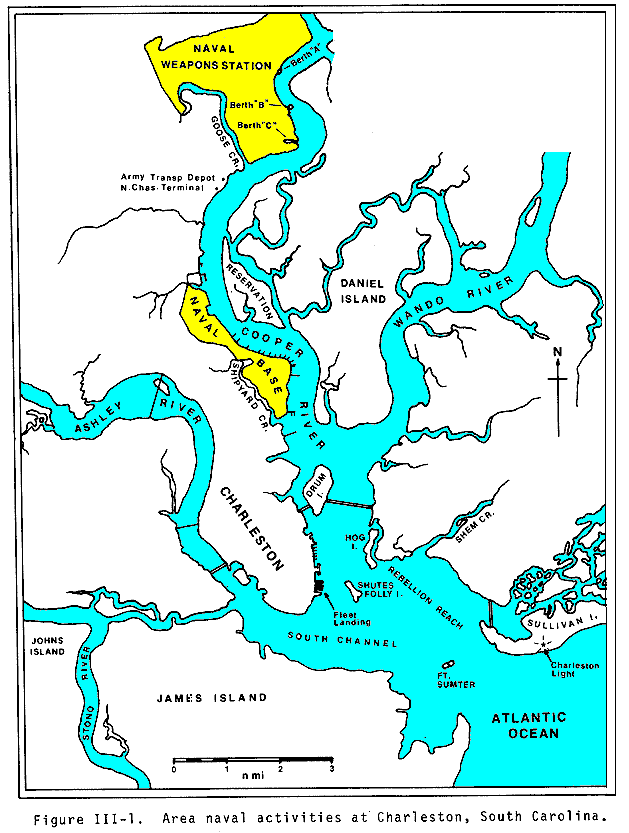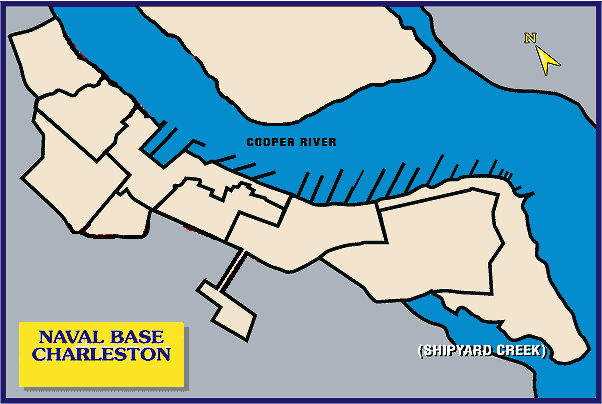



Charleston Naval Station
Charleston, South Carolina
The Charleston Naval Complex is located on the west bank of the Cooper
River about 5 miles north of Charleston, South Carolina. There are
multiple Naval commands located on the complex: Naval Shipyard (NSY),
Naval Station (NS), Naval Fleet and Industrial Supply Center (FISC), Fleet
and Mine Warfare Training Center (FMWTC), and the Naval Reserve
Center (NRC) (which is not a closing facility) and several other small
organizations. The Naval Station and Shipyard combined encompass approximately 1,800 acres. The property and the majority of the commands were slated
for closure by the Base Realignment and Closure (BRAC) commission in
1993, except for the FISC, which was closed by the BRAC commission in
1995. Four of the largest activities were listed for closure by the 1993
Base Realignment and Closure (BRAC) Commission: The Shipyard, Naval Station, Fleet and Industrial Supply Center, and the Fleet
and Mine Warfare Training Center. Operations on the complex ceased on
01 April 1996 with the complex to be transferred sometime after that,
depending on the cleanup schedule. The 1996 closure resulted in the loss of 8,722 military and 6,272 civilian jobs. Southern Division of the Naval
Facilities Engineering Command is the cognizant caretaker for the base.
The Charleston Naval Base was located on the west bank of the Cooper River about five miles north of the City of Charleston proper. Located within the confines of the base are the Naval Supply Center, the Naval Station, Charleston and the Naval Shipyard facilities. These activities provided the primary berthing, logistics and repair services to US Navy ships in the Charleston area.
The Naval Weapons Station is located about five miles north of
Charleston Naval Shipyard on the west bank of the Cooper River. Berth Alfa is 1100 ft long and Berth Bravo is 970 ft long. The Army Transportation Depot is located about two miles north of the Charleston Naval Shipyard on the west bank of the Cooper River. The Army Transportation Depot pier is 1500 ft long. North Charleston Terminal is located about 1.3 miles north of Charleston Naval Shipyard on the west bank of the Cooper River. The North Charleston Terminal is about 2460 ft long with a 12-ft deck height.
Anchorage for deep-draft vessels is available in the triangle westward of the junction of Rebellion Reach of the main channel with South Channel. However, if that anchorage is used, a scope of 10:1 (rather than the customary 7:1) should be used and a second anchor should be ready for use. This anchorage is not considered a good hurricane anchorage due to the poor holding quality and confined harbor space.
In October 1993, the reuse committee selected a consultant team to prepare a base reuse plan for the naval complex within eight months. The effort included the preparation of the reuse/redevelopment plan and the establishment of a Business Development Center to assist workers in transforming existing shipyard shops and functions into viable private businesses. In May 1994, the Committee unanimously approved the Civic and Marine Reuse Plan with a focus on five major employment areas: a shipyard
function, an industrial park, an office district, an intermodal cargo port district, and a rail-served marine industrial park. The plan also calls for a community park, a community support district providing facilities for the area's social service agencies (e.g., homeless providers), and public and recreational facilities for the city of North Charleston.
In June 1994, the South Carolina House and Senate passed legislation creating the Charleston Naval Complex Redevelopment Authority to administer the reuse/redevelopment of the naval base. The authority 12 appointed members: five from the city of North Charleston, one each from the city of Charleston, Berkeley County, Charleston County, and Dorchester County, one appointed by the House, one appointed by the Senate, and one appointed by the Governor to serve as initial Chairman. Total cost to the redevelopment authority is estimated at $60 million to prepare the property for redevelopment and job creation consistent with the redevelopment plan. The cost of building renovations and site improvements (parking, lighting, landscaping, utilities) within development parcels was estimated at over $200 million and would be undertaken by others.
Findings Of Suitability to Lease (FOSL) had been completed for 472 facilities at Naval Base Charleston as of 1996, and FOSLs for an additional 231 facilities were being prepared. No Findings of Suitability to Transfer (FOST) had been completed as of 1996. The Federal to Federal transfer of property (no FOST is necessary for fed to fed) at Naval Base Charleston to the National Oceanic and Atmospheric Administration (NOAA), the State Department, the United States Coast Guard, the United States Marine Corps, Naval Command Control and Ocean Surveillance Center In Service Engineering - East (NISE-East), and the United States Army Corps of Engineers involving over 1400 acres has taken place. Initial reuse plans include a privately-owned commercial shipyard, public recreational facilities and other community and commercial uses. The Border
Patrol has set up an academy on the base for the training of Border Patrol
and Immigration and Naturalization Service agents. The National
Community Civilian Corps (NCCC) is also located on the base. The
Defense Financial Accounting Service (DFAS) and the Defense Printing
Services Detachment Office (DPSDO) are using facilities on the base.
On Jan. 9, 1994, a new naval command was commissioned in Charleston, SC. The Naval Command, Control and Ocean Surveillance, In-Service Engineering, East Coast Division (NISE East) was established as a result of a 1993 Base
Realignment and Closure Commission (BRAC) decision. NISE East brought together the expertise of four former naval activities along the East Coast: Naval Electronic Systems Engineering Center, Charleston, SC; Naval Electronic Systems Engineering Center, Portsmouth, VA; Naval Electronic
Systems Engineering Activity, St. Inigoes, MD; and Naval Electronic Security Systems Engineering Center, Washington, DC. On Oct. 11, 1994, a ground-breaking ceremony celebrated the beginning of construction of the Navy's first custom-designed command, control, communications, computers, intelligence, surveillance, and reconnaissance (C4ISR) facility. Named in
honor of U.S. Senator Fritz Hollings at a ceremony on Aug. 21, 1995, employees began moving into the 256,000 sq.ft. building in May 1998. This event marked the accomplishment of the 1993 BRAC direction to consolidate the East Coast engineering activities.
The military remains a major industry in the Charleston area today, despite major downsizings. The 1995 round of Base Realignments and Closures resulted in the decision for Charleston to receive the Naval Nuclear Power Training Command transferring from Orlando, Florida, bringing with it 500 permanent active military jobs as well as 2,500 transient students attending the school each year. The Navy expects to have an estimated 7,800 active and civilian employees after the April '96 closure, with the 500 Power Training Command employees to be added by 1999.


Sources and Methods
http://www.fas.org/man/dod-101/fac/port/.htm
Maintained by Robert Sherman
Originally created by John Pike
Updated Sunday, December 06, 1998 5:59:17 AM






